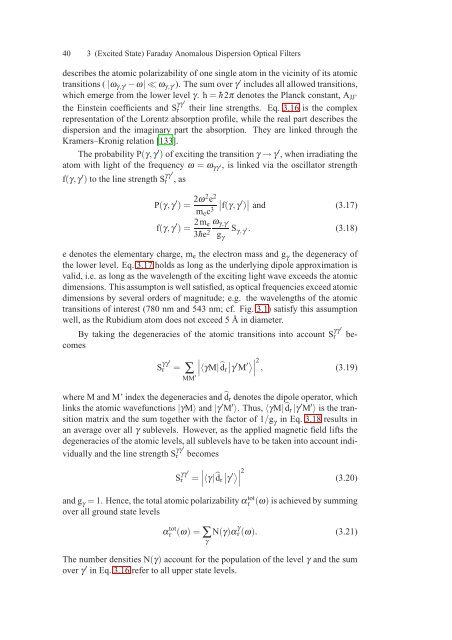Assessment of a Rubidium ESFADOF Edge-Filter as ... - tuprints
Assessment of a Rubidium ESFADOF Edge-Filter as ... - tuprints
Assessment of a Rubidium ESFADOF Edge-Filter as ... - tuprints
Create successful ePaper yourself
Turn your PDF publications into a flip-book with our unique Google optimized e-Paper software.
40 3 (Excited State) Faraday Anomalous Dispersion Optical <strong>Filter</strong>s<br />
describes the atomic polarizability <strong>of</strong> one single atom in the vicinity <strong>of</strong> its atomic<br />
transitions ( |ω γ,γ ′ −ω| ≪ ω γ,γ ′). The sum over γ ′ includes all allowed transitions,<br />
which emerge from the lower level γ. h = ¯h2π denotes the Planck constant, A JJ’<br />
the Einstein coefficients and Sr<br />
γγ′ their line strengths. Eq. 3.16 is the complex<br />
representation <strong>of</strong> the Lorentz absorption pr<strong>of</strong>ile, while the real part describes the<br />
dispersion and the imaginary part the absorption. They are linked through the<br />
Kramers–Kronig relation [133].<br />
The probability P(γ,γ ′ ) <strong>of</strong> exciting the transition γ → γ ′ , when irradiating the<br />
atom with light <strong>of</strong> the frequency ω = ω γγ ′, is linked via the oscillator strength<br />
f(γ,γ ′ ) to the line strength Sr<br />
γγ′ , <strong>as</strong><br />
P(γ,γ ′ ) = 2ω2 e 2<br />
m e c 3 ∣ ∣f(γ,γ ′ ) ∣ ∣ and (3.17)<br />
f(γ,γ ′ ) = 2m e<br />
3¯he 2 ω γ,γ ′<br />
g γ<br />
S γ,γ ′. (3.18)<br />
e denotes the elementary charge, m e the electron m<strong>as</strong>s and g γ the degeneracy <strong>of</strong><br />
the lower level. Eq. 3.17 holds <strong>as</strong> long <strong>as</strong> the underlying dipole approximation is<br />
valid, i.e. <strong>as</strong> long <strong>as</strong> the wavelength <strong>of</strong> the exciting light wave exceeds the atomic<br />
dimensions. This <strong>as</strong>sumpton is well satisfied, <strong>as</strong> optical frequencies exceed atomic<br />
dimensions by several orders <strong>of</strong> magnitude; e.g. the wavelengths <strong>of</strong> the atomic<br />
transitions <strong>of</strong> interest (780 nm and 543 nm; cf. Fig. 3.1) satisfy this <strong>as</strong>sumption<br />
well, <strong>as</strong> the <strong>Rubidium</strong> atom does not exceed 5 Å in diameter.<br />
be-<br />
By taking the degeneracies <strong>of</strong> the atomic transitions into account Sr<br />
γγ′<br />
comes<br />
S γγ′<br />
r<br />
= ∑<br />
MM ′ ∣ ∣∣〈γM|̂dr<br />
∣ ∣ γ ′ M ′〉∣ ∣ ∣<br />
2<br />
, (3.19)<br />
where M and M’ index the degeneracies and ̂d r denotes the dipole operator, which<br />
links the atomic wavefunctions |γM〉 and |γ ′ M ′ 〉. Thus, 〈γM|̂d r |γ ′ M ′ 〉 is the transition<br />
matrix and the sum together with the factor <strong>of</strong> 1/g γ in Eq. 3.18 results in<br />
an average over all γ sublevels. However, <strong>as</strong> the applied magnetic field lifts the<br />
degeneracies <strong>of</strong> the atomic levels, all sublevels have to be taken into account individually<br />
and the line strength Sr<br />
γγ′ becomes<br />
Sr γγ′ ∣ ∣<br />
= ∣〈γ|̂d r γ ′〉∣ ∣2<br />
(3.20)<br />
and g γ = 1. Hence, the total atomic polarizability α tot<br />
r (ω) is achieved by summing<br />
over all ground state levels<br />
α tot<br />
r<br />
(ω) = ∑N(γ)αr(ω). γ (3.21)<br />
γ<br />
The number densities N(γ) account for the population <strong>of</strong> the level γ and the sum<br />
over γ ′ in Eq. 3.16 refer to all upper state levels.
















